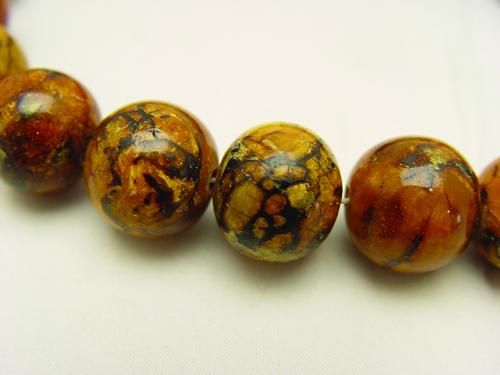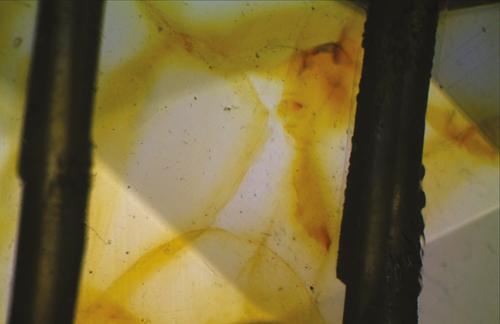
This article by Guy Lalous ACAM EG summarises a technical article from The Journal of Gemmology discussing the identification criteria for early (pre 2009) and current (post 2009) reconstructed amber, based on documented samples at the National Gemstone Testing Center (NGTC) in Beijing.
Newer amber material presents a serious identification challenge for gemmological laboratories. By comparing the structure of reconstructed amber with that of natural amber, is it possible to identify it?
Read more: Diving into the World of New Zealand Paua Shells
Amber is formed from fossilised tree resin, but may have inclusions of animals, insects, plant debris, minerals, liquids and gases. The fossilisation process involves a progressive oxidation, where the original organic compounds gains oxygen, and polymerisation, which is an addition reaction where two or more molecules join together. This process produces oxygenated hydrocarbons, which are organic compounds made of oxygen, carbon and hydrogen atoms.
What is reconstructed amber?
Reconstructed amber consists of small amber fragments or scraps that have been reformed into larger pieces under heat and pressure. It is commonly manufactured from pieces of Baltic material. According to the process used, two main types of reconstructed amber exist:
Type 1 made without the addition of any substances to the amber fragments.
Type 2 which contains foreign substances (e.g. natural or artificial resins) that are added to make the material more solid and durable.

13 mm diameter beads made of reconstructed amber containing foreign substances
What is Baltic amber?
Baltic amber is fossil resin from coniferous trees. Baltic amber, also called succinate, contains 3-8% succinic acid. It was formed about 44 million years ago and today it is found in forests in Lithuania, Russia and Poland, where it is mined and exported in large quantities. The origin is confirmed by the presence of a ‘Baltic Shoulder’ in the fourier transform infrared spectroscopy (FTIR) spectra. Infra-red (IR) spectroscopy is the most effective scientific method for identifying fossil resins.
What are the identification features of heated amber?
Heat-enhanced amber contains brownish flow lines. These flow lines result from the oxidation of pre-existing cracks that are healed during enhancement at low temperature and pressure, to solidify the raw material and to help avoid future cracking. The heating process will change the refractive index (RI) and infrared spectral readings. The higher the temperature used, the higher the RI will be, up to a maximum of 1.60. Exposure to greater temperatures may also alter some of the FTIR features: the ~1735 cm−1 absorption band shifts to down to 1716 cm−1, and the ~1157 cm−1 absorption band moves up to 1175 cm−1. The variations in RI and infrared spectra indicate that an amber specimen has been heated, but they do not provide conclusive evidence of reconstruction.
Read more: Getting to Grips with GemTof Technology
When there is little or no foreign substance present, the FTIR spectra of reconstructed amber looks almost identical to that of natural amber, and additional examinations using a microscope, polariscope and UV lamp should be performed to make the proper identification. Most samples encountered at NGTC are type 1 reconstructed amber.
What are the identification features of early reconstructed amber?
Early reconstructed amber involved the use of relatively high temperature and pressure conditions in air. It is relatively easy to identify. The material displays a relatively dark body colour, poor transparency with a muddy-looking interior, and a diagnostic fragmental or mosaic structure (known as ‘blood streak’ in Chinese as it resembles blood vessels). The boundaries between fragments have oxidised (darker) edges that appear translucent brown or red. In addition to this some early-stage reconstructed amber may display uneven surface lustre, due to different hardness characteristics of the partially melted amber fragments.


A 3-D mosaic structure in early reconstructed amber shows a network of angular boundaries that completely enclose the fragments. Below: By contrast, heat-enhanced amber displays brownish red flow lines that do not interconnect. Magnification 10x
How can you differentiate between natural and reconstructed amber?
Natural amber is amorphous and often shows anomalous double refraction in the polariscope, sometimes displaying snake-like, wavy or patchy extinction patterns. By contrast, early-stage reconstructed amber shows patchy grainy extinction, with clear grain boundaries and often exhibits interference colours.
Natural amber usually displays even fluorescence, viewed with a UV lamp or in a DiamondView instrument. While darker-coloured early-stage reconstructed amber may not show diagnostic fluorescence, pale-coloured material commonly shows uneven luminescence with a fragmental or granular structure.
What are the identification features of current-stage reconstructed amber?
Current-stage reconstructed amber is manufactured under relatively higher temperature and pressure in an oxygen-free environment. It is often subjected to post-processing treatments that are designed to conceal identifying features. These include inducing internal and surface cracks (by heating and cooling), polishing with coarse grit to create a matt appearance, darkening the surface colour (by baking), carving complex patterns and applying coloured coatings. Microscopic observation reveals that finer grains are typically used as raw material for current reconstructed amber. Usually showing a more subtle and fine-grained fragmental structure consisting of areas of pale colour are enclosed by dot-like edges. The dark-coloured grain boundaries are nearly absent and can only be seen with careful observation, the ‘blood streak’ structure is not apparent. The post processing treatments obscure the features observed with the polariscope, UV lamp or the DiamondView.


Above: Viewed with a strong transmitted light source, this opaque reconstructed amber bead exhibits no ‘blood streak’ structure, although the angular fragments are still apparent. Below: Two beads in an amber bracelet consist of natural amber (left) and current reconstructed amber (right) display fuzzy grain boundaries with no ‘blood streak’ structure. The presence of small grains with angular boundaries is the key identification factor for the reconstructed amber bead. Magnification 16x (left) and 12.5x (right)
Conclusion
The most effective method to identify reconstructed amber from natural amber is microscopy, to observe the internal microstructure. The Polariscope and UV Fluorescence are useful auxiliary methods but cannot be used to reliably separate current reconstructed natural amber. ■
This is a summary of an article that originally appeared in The Journal of Gemmology entitled ‘Identification of Reconstructed Amber from Different Periods’ by Haibo Li, Jie Liang, Taijin Lu, Jun Zhang and Jun Zhou 2016/Volume 35/ No. 4 pp. 320-328
Interested in finding out more about gemmology? Sign-up to one of Gem-A’s courses or workshops.
If you would like to subscribe to Gems&Jewellery and The Journal of Gemmology please visit Membership.
Cover image Flanky internal cracks, eviddence of post processing heat treatment in current reconstructed amber. All photos by H. Li
{module Blog Articles Widget}


